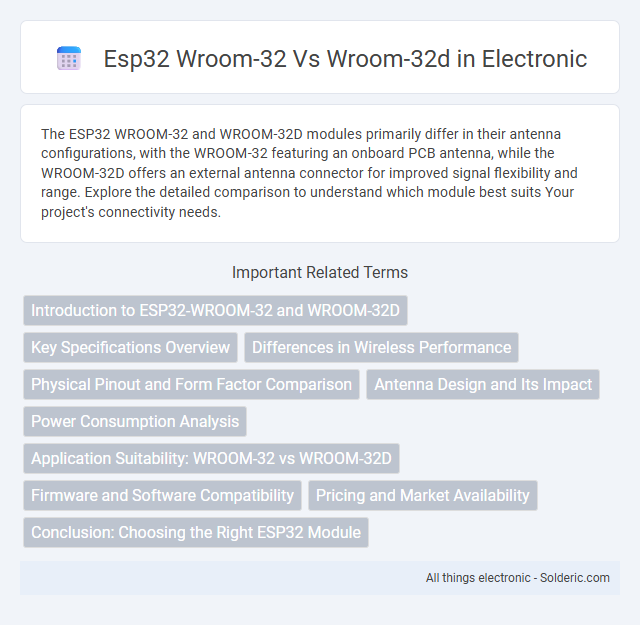The ESP32 WROOM-32 and WROOM-32D modules primarily differ in their antenna configurations, with the WROOM-32 featuring an onboard PCB antenna, while the WROOM-32D offers an external antenna connector for improved signal flexibility and range. Explore the detailed comparison to understand which module best suits Your project's connectivity needs.
Comparison Table
| Feature | ESP32 WROOM-32 | ESP32 WROOM-32D |
|---|---|---|
| Wi-Fi Standard | 802.11 b/g/n | 802.11 b/g/n |
| Bluetooth | Bluetooth v4.2 BR/EDR and BLE | Bluetooth v4.2 BR/EDR and BLE |
| Microcontroller | Espressif ESP32 dual-core | Espressif ESP32 dual-core |
| Flash Memory | 4MB (varies by model) | 4MB (varies by model) |
| Operating Voltage | 3.0V - 3.6V | 3.0V - 3.6V |
| Package Dimension | 18mm x 25.5mm | 18mm x 25.5mm |
| Antenna | PCB trace antenna or external antenna option | Integrated PCB antenna, optimized for better RF performance |
| Key Difference | Standard module with external antenna support | Improved RF performance and integrated antenna design |
Introduction to ESP32-WROOM-32 and WROOM-32D
ESP32-WROOM-32 and WROOM-32D are powerful Wi-Fi and Bluetooth modules by Espressif Systems, designed for seamless IoT integration. The WROOM-32D features an upgraded PCB antenna, enhancing wireless performance and reliability compared to the original WROOM-32. Your choice depends on specific application needs, such as antenna design and environmental factors influencing signal strength.
Key Specifications Overview
The ESP32-WROOM-32 and ESP32-WROOM-32D modules feature the same powerful dual-core ESP32 chip with integrated Wi-Fi and Bluetooth connectivity, supporting up to 240 MHz CPU frequency. Both modules offer 4MB of embedded SPI flash memory and 520 KB SRAM for efficient application storage and execution. The main distinction lies in the antenna configuration: the WROOM-32 includes an onboard PCB antenna, while the WROOM-32D provides an IPEX antenna connector for external antenna options, enhancing flexibility in wireless performance.
Differences in Wireless Performance
The ESP32-WROOM-32D offers improved wireless performance over the standard WROOM-32 due to enhanced antenna design and better RF front-end components, resulting in stronger signal strength and greater range. Both modules support dual-mode Wi-Fi and Bluetooth, but the WROOM-32D often delivers more consistent connectivity in challenging environments. Your choice between these models should consider the specific wireless requirements of your project for optimal performance.
Physical Pinout and Form Factor Comparison
The ESP32 WROOM-32 and WROOM-32D modules share an identical physical pinout, enabling seamless compatibility across most development boards and accessories. Both modules feature a compact 18mm x 25.5mm form factor, making them suitable for space-constrained IoT applications. If your project requires precise mechanical integration, the consistent pin configuration ensures you can confidently choose either variant without redesigning your PCB layout.
Antenna Design and Its Impact
The ESP32 WROOM-32 features an onboard PCB antenna optimized for compact designs, while the WROOM-32D offers a similar internal antenna but with FCC and CE certifications tailored for global markets. Antenna design in both modules directly influences signal strength, range, and RF performance, with slight variations in matching networks contributing to compliance and efficiency. Choosing between these modules depends largely on regulatory requirements and desired antenna reliability for stable Wi-Fi and Bluetooth connectivity.
Power Consumption Analysis
The ESP32-WROOM-32 and ESP32-WROOM-32D modules exhibit similar power consumption profiles due to their shared ESP32 chip architecture, with both supporting deep sleep current as low as 5 uA. The WROOM-32D variant features an internal PCB antenna, which can lead to slightly lower power usage in RF transmissions compared to the external antenna of the WROOM-32, optimizing energy efficiency in wireless communication. Power consumption in both modules varies significantly depending on operation mode, clock frequency, and peripheral usage, making careful configuration essential for battery-powered applications.
Application Suitability: WROOM-32 vs WROOM-32D
ESP32 WROOM-32 and WROOM-32D modules both offer robust performance for IoT applications, but WROOM-32D includes an integrated PCB antenna optimized for improved wireless range and connectivity in dense environments. Applications requiring reliable Wi-Fi and Bluetooth communication with limited external antenna design flexibility benefit from the WROOM-32D's compact solution. You should consider WROOM-32 for projects where custom antenna design or extended wireless range is needed.
Firmware and Software Compatibility
ESP32 WROOM-32 and WROOM-32D modules share identical ESP32 SoC, ensuring full firmware and software compatibility across both platforms. Both support ESP-IDF and Arduino frameworks, enabling seamless deployment of applications without requiring code modifications. Differences in antenna configurations do not impact the underlying software ecosystem or development tools.
Pricing and Market Availability
The ESP32-WROOM-32 typically offers a more affordable price point compared to the ESP32-WROOM-32D due to slightly fewer features and variations in antenna configuration. Market availability favors the ESP32-WROOM-32 as it is widely stocked by numerous distributors, facilitating easier procurement for your development projects. Prices for both modules can fluctuate based on supply chain factors, volume purchasing, and regional demand, so comparing vendor offerings is essential for cost optimization.
Conclusion: Choosing the Right ESP32 Module
ESP32-WROOM-32 and ESP32-WROOM-32D primarily differ in antenna configuration, with the WROOM-32 featuring an onboard PCB antenna and the WROOM-32D offering an external antenna connector for enhanced signal flexibility. Selecting the appropriate ESP32 module depends on application requirements for wireless range, physical design constraints, and antenna performance. The WROOM-32 suits compact, integrated projects, while the WROOM-32D is ideal for environments demanding superior connectivity or customized antenna solutions.
esp32 wroom-32 vs wroom-32d Infographic

 solderic.com
solderic.com